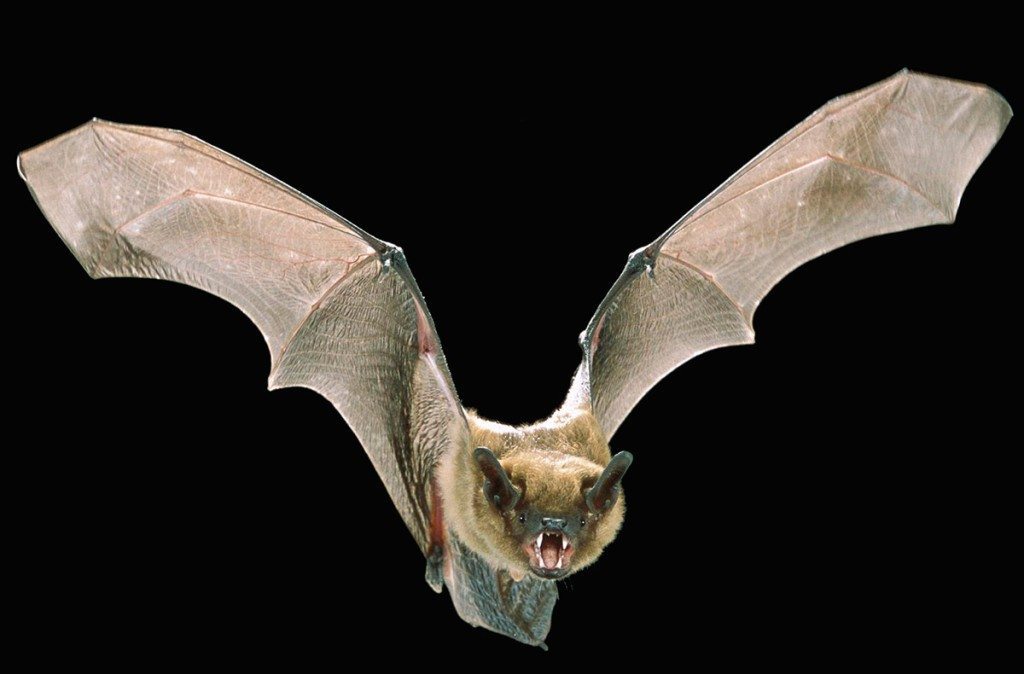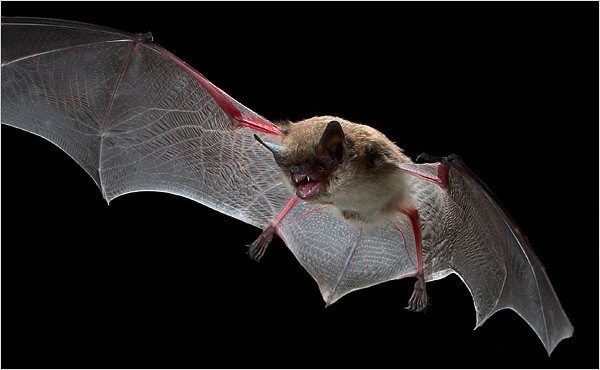Despite the fact that bat caves will have a thick layer of ‘guano’ (bat poo) on the floor, bats have been described as being ‘like little cats’ because they are very clean, and spend most of their time grooming themselves when they’re not eating or sleeping! One of the notable bat facts is that in Africa, bats are involved a lot in fetish ceremonies and some traditional concoctions. Because they are nocturnal birds that rather prefer sleeping upside down makes them one of the most bizarre animals in Africa. Answers Africa brings you some of the fascinating facts about bats.
Bat Facts – General
1 – Bats are the only mammals capable of true, sustained flight, as opposed to merely gliding in the air like flying squirrels, colugos and some possums do. Their wings are in fact their forelimbs, with the part they flap being the hand, formed of extremely elongated fingers connected by a thin membrane called a ‘patagium’. This membrane also extends down to the much shorter legs and continues between them, too.
2 – The approximately 1,240 known species of bats worldwide make up around a fifth of the total classified mammal species in the world. Their order, Chiroptera, is divided into two sub-orders, the megabats or flying foxes, which mostly eat fruit but are less specialised, and the microbats, which are the echo-locating, highly specialised bats.
3 – Bats are found almost everywhere on the planet in pretty much every type of habitat with the only exceptions being the two poles and a few small oceanic islands. As long as there is somewhere to safely rest, or ‘roost’ – e.g hollows, crevices, or suitable man-made structures – and somewhere to forage for food, there’ll probably be bats sooner or later. They’re even known to bite leaves to shape ‘tents’ for themselves in which to roost if no other suitable place can be found.
4 – Bats have a quite extraordinarily long lifespan for their size – they are known to live to around 20 years, and at least one brown bat was documented to have lived for 30 years. Compared to similar-sized rodents, who live for only a year or two, this is phenomenal!
5 – The smallest bat species is the Kitti’s Hog-nosed Bat, weighing up to 2.6 g (0.09 oz) and measuring just 34 mm (1.34 in) in length, with a 15 cm (5.91 in) wingspan – in fact, this minuscule little animal is possibly the smallest species of mammal currently alive (the Etruscan shrew is the other possibility).
6 – At the other end of the scale, the largest bats are a selection of the flying foxes (genus Pteropus) and a so-called flying fox, the Giant Golden-Crowned, which, despite its name, is not actually of the same genus – its genus is Acerodon. Weighing up to 1.2 kg (2.6 lb) and with a wingspan of up to 1.7 m (5 ft 7 in), it probably wouldn’t notice if it stepped on one of its tiny hog-nosed relatives!
7 – The local name for bats in many languages translates as ‘mouse’, for instance, they are ‘bald mouse’ (chauve-souris) in French, ‘blind mouse’ (murciélago) in Spanish and ‘old mouse’ (saguzahar) in Basque. In old English, they are known by the picturesque ‘flittermice’, which is also in line with the Swedish name, Fladdermus and the German one, Fledermaus.
Bat Facts – Characteristics
8 – In general, the two sub-orders of bat, megabats (megachiroptera) and microbats (microchiroptera), are identified as separate by four features –
- generally, megabats do not use echolocation (the exception is Rousettus and its relatives),
- megabats have a claw at the end of the second finger;
- the ends of megabats ears close up to form a ring, and
- megabats have underfur, where microbats have guard hairs or are naked.
9 – Although bat wings are ‘true’ wings, they are similar to bird’s wings only in that they are formed from their elongated forelimbs. Bats’ wings are very delicate, with flexible finger bones and an elastic membrane that enables bats to manoeuvre very quickly and accurately – as anyone who has seen them ‘zipping’ around can testify! The delicate nature of the membrane means that it can easily be torn, but it can also regrow and heals very quickly.
10 – Bats also have small, touch-sensitive receptors called Merkel cells on the wing surface (similar to human fingertips), but in bats each one includes a tiny hair as well, enabling the bat to feel air moving over its wings and adjust their shape in response for more efficient flight.
11 – One of the strange bat facts is that all mammals are protected from blood flowing backwards by one-way valves in their veins, but bats have taken this one a stage further – they have these valves in their arteries too.
12 – The tube-lipped nectar bat (Anoura Fistulata) holds another record – relative to its body size, its tongue is the longest in any existing mammal! It developed this to enable it to delve right into the long cups of some of the flowers it feeds from, pollinating them as it goes. Then when it retracts the tongue – it coils it up inside their ribcage!
Bat Facts – Behaviour
13 – Bats are highly specific about what they eat. Nearly three-quarters eat just insects, and almost all of the rest eat fruit, with just a few species specialising in eating animals apart from insects, e.g the fish-eating bats, and, of course, the vampire bats.
14 – Bats are vital to the ecology, as they disperse fruit seeds and pollinate flowers wherever they live, and the insect-eaters help to keep pest numbers down. Also, contrary to popular belief, bats can see perfectly well, thank you – they just don’t use sight as much as most mammals do.
15 – The bat’s echolocation system is quite simple in principle; the bat emits ultrasonic sounds at up to 130 decibel – making them one of the intensest sounds in existence made by airborne animals – and then analyses the returning echoes to gain detailed knowledge of everything in its vicinity.
16 – The main problem bats could have with this system is having sensitive enough hearing to identify and analyse the echoes, whilst making sure they don’t deafen themselves with those loud outgoing calls! Different bats use two different methods of getting round this – in one, the bat squeezes its ears shut while calling, then stops calling and relaxes its ears in time to hear the return (‘low duty cycle echolocation’), and in the other its ears are tuned to a very small, very specific frequency range, and they emit calls just outside this range, because the Doppler shift occasioned by their flying motion occurs, the echoes come back within the range they can hear (‘high duty cycle echolocation’).
Michael Durham/Getty Images
17 – The insect-eating bats have evolved another clever ability to do with their ears – they have become very sensitive to the sounds moth wings make when fluttering. as they move along the ground. They do this through the complex ridges on the inner surfaces of their ears, which help them to focus on these sounds.
18 – Bats usually mate in the autumn, delay gestation until spring, then give birth to one large, well-developed live young. The baby spends the first few days clinging to mother’s chest, feeding from her nipples, but as it begins to grow bigger it will stay in the roost and wait for mum to come back to feed it. The mother will feed her youngster until it is pretty much adult since bats can’t hunt until they have fully developed wings, which is at around 6-8 weeks for the microbats and four months for the megabats.
See Also: Dragonfly Facts, Pictures and Symbolism
19 – Bats do drink water, and have developed two methods of acquiring it; some fly low over the water, drop their lower jaw and carefully collect a single drop to swallow, then repeat this until they have had their fill. Others fly a little lower, allowing their chests to contact the water, then settle somewhere and lick the moisture off. Mind you, this was only discovered when scientists managed to develop cameras that could take over 1,000 photos a second in order to capture the bats in action!
20 – Yes, vampire bats do exist and yes, they do feed exclusively on blood! There are three species; Common Vampire Bat, which feeds on mammals, the White-winged and Hairy-legged Vampire Bats (someone ran out of imagination in naming these!), which feed on birds. However, they don’t ‘suck’ the blood in the traditional vampire manner – they do pierce the skin with their sharp teeth, but then they fold back a small flap and lap up the welling blood, which won’t clot because of an anti-coagulant in their saliva. However, they rarely take enough blood to seriously harm their prey, although secondary infections can be a problem.
Finally, vampire bats rarely bite humans, and in any case, they have a lower rate of incidence of rabies than other animals such as skunks and foxes (and not at all in Britain, of course). In fact, only a tiny fraction of bat bites have ever caused rabies in a human, and since bat bites are so rare in the first place, that incidence becomes so low as to be negligible! That’s all the interesting bat facts you are now in the know of.

